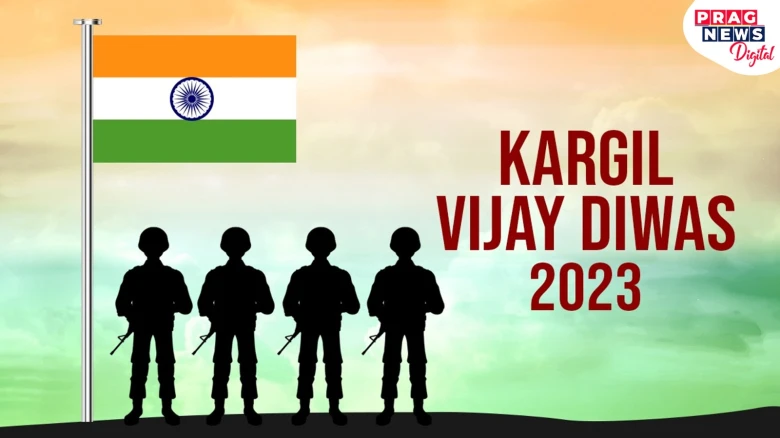Regional

The Kargil War is one of the most memorable chapters in India's modern military history...
Digital Desk: The Kargil War is one of the most memorable chapters in India's modern military history. Every year on July 26—the day of the Kargil War victory—the entire nation pays tribute to heroes of the Indian Armed Forces who gave the ultimate sacrifice by laying down their lives in service to India.
The Kargil Vijay Diwas, observed on July 26, is devoted to the war heroes who defended India's borders from intrusion when the Pakistani Army, supported by tribal militia, attempted to invade the border district of Kargil in Ladakh (then part of Jammu and Kashmir) in 1999.
Here are 10 interesting facts about the Kargil War that shed light on this momentous chapter:
1. The Kargil War: Why did it happen?
The Kargil War broke out between India and Pakistan on May 8, 1999, in the Kargil district of Ladakh (then part of Jammu and Kashmir), when the Pakistani Army and Islamabad-sponsored tribal militia crossed the Line of Control (LoC) into Indian territory during the winter of 1998.
The intruders had taken over entrenched defenses overlooking the national highway in Kargil's Drass as well as the Batalik Sector in Ladakh, which became the main point of the fight due to its strategic importance. Military officials think the Pakistani intruders planned to enter and conquer the Kashmir valley region after capturing control of the main highway connecting the valley to Ladakh.
2. "Operation Vijay"
"Operation Vijay" was the code name given to the Indian military's campaign to drive out the invaders and retake the captured Indian territory in Kargil.
3. Kargil War Strategy
The Kargil War was fought in three stages
Recognize the strategic positions that Pakistan has taken and reclaim these important territories. This included opening up the NH1-A to allow military traffic to pass through.
Identify and drive out Pakistani intruders from the region. This included ground battles between Indian and Pakistani troops.
Maintain a firm military hold on the retaken position so that the intruders do not try to seize it again.
4. Harsh terrain
The Kargil War of 1999 was fought in the challenging environment of the mountainous Ladakh area. The Indian soldiers endured the freezing cold and fought their way across the inhospitable terrain to drive away the intruders who had invaded Indian Territory. The conflict was possibly the most difficult in recent memory since it was fought at very high altitudes and in hilly terrain, with some stations placed at elevations of over 18,000 feet.
5. Casualties
The Kargil War came at a heavy price in terms of human lives. According to official figures, around 500 Indian soldiers made the ultimate sacrifice, while at least 1,000 Pakistani troops lost their lives.
6. Armaments used in Kargil war
The Indian Army employed a combination of heavy artillery, airpower, and infantry operations during the conflict. Notably, the renowned Bofors FH-77B howitzers were used effectively to neutralize enemy positions at high altitudes. Israel provided crucial support by supplying its Unmanned Aerial Vehicles (UAVs) to India during the war.
7. IAF role
The Indian Air Force played a pivotal role in ensuring India's victory. The IAF conducted targeted airstrikes, bombing key enemy positions, and providing crucial aerial support to the infantry on the ground.
8. The War on Live Television
The Kargil War marked a significant milestone in media coverage, as it became the first-ever war to be broadcast live on Indian TV channels. The live updates from the battlefield kept the citizens informed about the unfolding events.
9. Areas recaptured by India
Through their unwavering determination, the Indian Army succeeded in recapturing several strategic areas, most notably Tiger Hill, Point 4875, and Tololing. These victories were vital in securing the upper hand in the conflict.
10. Military Honours Awarded
The gallant soldiers of the Indian Army who displayed exceptional valor during the Kargil War were honored by the Indian government. Captain Vikram Batra of the Indian Army, who made the ultimate sacrifice, was posthumously awarded the Param Vir Chakra - India's highest gallantry award. Additionally, Lieutenant Manoj Kumar Pandey, Rifleman Sanjay Kumar, and Grenadier Yogendra Singh Yadav were also honored with this prestigious award, along with 11 Maha Vir Chakras that were awarded for acts of exceptional bravery.
The Kargil War remains etched in the annals of history as a testament to the courage and dedication of the soldiers who selflessly defended their motherland. It also serves as a reminder of the need for peaceful resolutions to conflicts, fostering hope for better relations between India and Pakistan in the years to come.
Leave A Comment